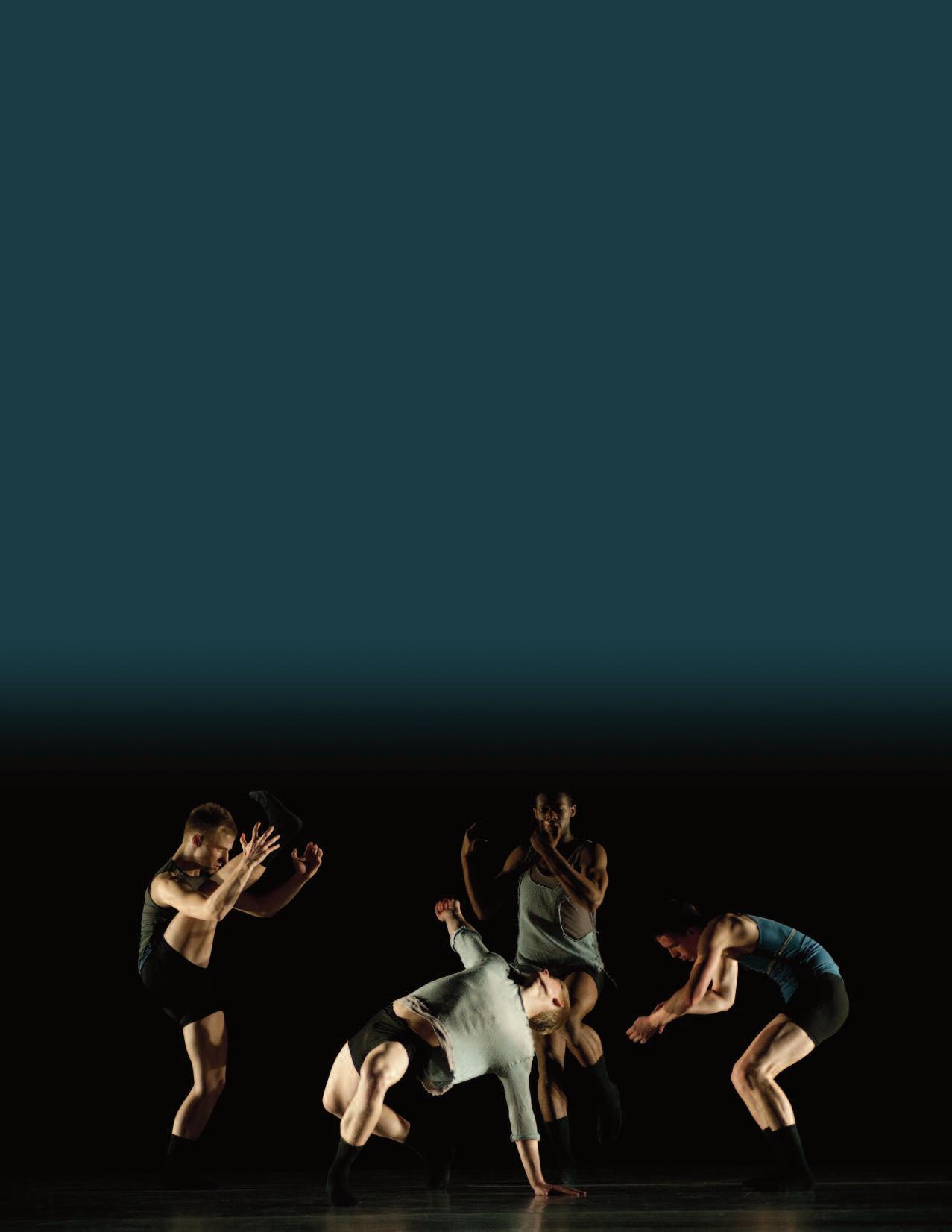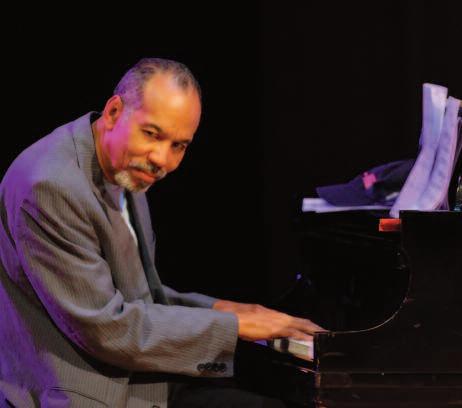
8 minute read
Faculty & Staff News
The rumor is that LaToya Ruby Frazier, Mason Gross Galleries at Civic Square curator and faculty member, may be changing careers and giving up art for high fashion. The New York Times announced Frazier ’ s inclusion in the Whitney Biennial 2012 with a series of photos of her work introduced by a shot of Frazier in haute couture. It is an interesting and intentionally ironic contrast to the tough, probing quality of her photo documentary work, much of it dealing with her family and her coming of age in Braddock, Pa., an industrial city long on the skids. Music faculty member Darryl Bott recently received the New Jersey Music Educators Association Distinguished Service Award in recognition of his years of service in promoting music education throughout the state. The award citation notes that Bott’ s talents and contributions have benefited not only students at Mason Gross but have had a positive impact on student musicians throughout the state. Theater faculty member Deborah Hedwall recently appeared in a new play, The Fall to Earth, at the 59E59 Theaters in New York City. The play was well reviewed in The New York Times by Eric Grode. In his largely positive review, he notes some minor problems with the play before going on to note: “Luckily, the tireless Ms. Hedwall dives into her pinwheeling character with relish, papering over some less plausible moments as she demonstrates how Fay simultaneously attracts and repels anyone in her orbit. Within minutes, the same woman marveling at the ‘ smallest, cutest typewriter I’ ve ever seen ’ on her daughter ’ s cellphone has hurled that same phone out the hotel window. ” In the brief period since the Rutgers Center for Digital Filmmaking was established in June 2011, the center has made its presence felt across the university and the state. Under the direction of Dena Seidel, assisted by a staff of Rutgers University alums Chantal Eyong and Jim Monahan, the center has major film projects underway, including a collaboration with Greg Blimling, Vice President for Student Affairs, to create a documentary on veterans returning to campus to continue their education; a film with Peter Gillies, director of the New Jersey Institute for Food, Nutrition, and Health to document a cooperative and ambitious program intended to combat childhood obesity in New Jersey; and with the School of Environmental and Biological Sciences to film Antarctica Quest, a documentary about Rutgers scientists studying climate-change issues in Antarctica. At the same time, the joint SAS/ Mason Gross filmmaking course component of the center has expanded greatly to include a far fuller array of course offerings and is poised to eventually expand the certificate program into a major. Seidel also has been interviewed by New Jersey Monthly for an article to appear in April 2012, and NJTV has agreed to air the documentary projects the center produces as a part of a regular series called NJ Docs. (Read more about the broadcasts on page 9 of the Mason Gross magazine.) Theater chair David Esbjornson recently staged an off-Broadway revival of Edward Albee ’ s intense drama The Lady from Dubuque starring Tony-winner Jane Alexander. The play deals with a game the characters play— “Who Are You ” —and comes up with life-and-death possibilities to the meaning of that question for the characters, at least those who remain on stage after the first act concludes. Esbjornson comes to this project after his recent successful staging of Driving Miss Daisy on Broadway and in London ’ s West End starring James Earl Jones and Vanessa Redgrave, and his Shakespeare in the Park production of Measure for Measure. Ben Brantley, in his laudatory New York Times review of The Lady of Dubuque, cited Esbjornson ’ s “ crisp ” direction and the way “this exquisitely mounted production illuminates ” the play. Maureen Hurd got the chance to perform at Steinway Hall in the fall and to showcase her Mason Gross clarinet students at the same time. Hurd is a Conn-Selmer Artist, and Henri Selmer Paris organized a week of performances and workshops that included Hurd, our students, Todd Levy, principal clarinet of the Milwaukee Symphony, and others. Barbara Gonzalez-Palmer accompanied Hurd during her performance.
Faculty & Staff
Advertisement
Recent alums, from left, Nick Sciscione, Scott Schneider, Kyle Marshall and Tyner Dumortier, are members of Professor Randy James ' new all-male dance company. Alum Alex Biegelson, not pictured, is also part of the company, called 10 Hairy Legs.

Professor Stanley Cowell

LARRY LEVANTI Dance professor Randy James is organizing a new all-male dance company featuring five of our recent alumni. Once fully established, the company plans a New York City season in which the group will perform a broad range of works from many of the most prominent choreographers. The company consists of Dance Department alums Kyle Marshall, Tyner Dumortier, Scott Schneider, Nick Sciscione and Alex Biegelson. With dancers of this caliber, the new company can ’t miss. James also had his dance The Day After Jesus Was Born performed at the 92nd Street Y in New York City. Music professor Stanley Cowell had a busy year performing at a number of important venues inter- nationally, including two Italian theaters— Teatro Manzoni in Milan and Teatro Dell’Ossevanza-Imola near Bologna— and Billboard Japan in Tokyo, among others. He also was featured pianist at a two-concert replication of John Coltrane ’ s Africa Brass at Lincoln Center ’ s Rose Hall. Cowell released two CDs and is topping off the year by receiving an honorary doctoral degree from his undergraduate alma mater, Oberlin College in Ohio. Time to take a welldeserved bow, Stanley! —DB
FACULTY PROFILE: Keith A. Thompson, Dance
Catch students performing Thompson’s choreography at DancePlus Spring April 20-29, 2012, at the Victoria J. Mastrobuono Theater.

Choreographer Keith A. Thompson grew up in a military family. But the idea of the dancer as a rhythmic soldier, mirroring prescribed movements and regurgitating patterns, seems to leave him cold.
“I love to have conversations with dancers about subject matter, ” says Thompson, a recent addition to the Mason Gross School’ s Dance Department. He also helms his own company, danceTactics Performance Group, and serves as rehearsal director for Liz Lerman Dance Exchange. “It gets pretty emotional. If they ’ re working with me, and they don ’t connect to me as a human being—if they don ’t know me as Keith—there ’ s only a certain amount of distance we can go.
“If we open up . . . that investment goes even deeper, ” continues Thompson, a member of Trisha Brown Dance Company from 1992 to 2001. “And trust—that enriches the movement. What we ’ re doing is very intimate and intricate. How do you achieve these things if you don ’t connect on a deeper level?”
Thompson began his training relatively late, as a student at The Ohio State University.
“I knew nothing about dancing, ” he says. “But my roommate said: ‘You ’ re always dancing around the room; I dare you to audition. ’ ”
Thompson says he “ connected to the rhythms ” of jazz in his college dance classes but detested ballet and modern. He dropped out of school and spent a few years in Minneapolis as a computer programmer. He spent nights studying dance, which eventually led to a spot in the city ’ s Zenon Dance Company and the end of his computer career.
“I walked into my boss ’ office and said, ‘It’ s my birthday, and I’ m quitting, ’ ” Thompson recalls. “I said, ‘I want to be a dancer. ’ ” Eventually, he nabbed a full scholarship to The Ailey School in New York City.
But Thompson credits Trisha Brown with nudging him toward artistic maturity.
“Trisha trained me to be a thinking dancer, not just a doer, ” says Thompson, who is collaborating this semester on a project with actor Bill Pullman. “A thinking dancer is a dancer who takes initiative and is making choices. They will run with their imagination, which gives choreographers not just one appetizer but a platter to choose from. ”
Mason Gross dancer Myssi Robinson says Thompson is keen on nurturing “thinking dancers ” himself.
“It is not enough to mimic, ” Robinson says of Thompson ’ s approach. “He requires that his students also understand the origins and complexities of each movement exercise. This process of . . . verbalization was very challenging. ”
Thompson admits that he still struggles with “ promoting myself and patting myself on the back, ” but that Brown fueled his confidence.
“I felt she valued my opinions, trusted my outcomes and didn ’t toss them away, ” says Thompson, who has performed internationally as a professional dancer for some 25 years. “She allowed me to be me and not be the mimic. If you trust a collaborator and feel they trust you, you allow yourself to be more vulnerable. ”
Establishing trust among his dancers seems to be working. Robinson recalls her first impression of Thompson: “He seemed very relaxed, yet slightly nervous, which was endearing . . . He is tuned in to our experiences as students. ”
Ideally, Thompson says, his dancers emerge hungry to seize on a movement, absorb it, embody it—maybe even wrestle with it.
“The most important thing is knowing that they ’ re trained but [also] knowing that there ’ s more, ” Thompson points out. “They can take ownership of their learning. Don ’t just listen, but challenge me. ” —LG

Thompson, foreground, in rehearsal.







